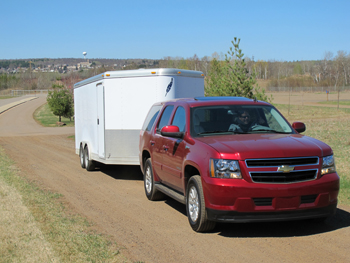Tow-testing Chevy's 2-Mode Hybrid Silverado
Buying a full-size truck can be a blindingly expensive proposition, with many models easily cresting $30,000 with popular options. Throw down for leather, navigation system and other goodies, and you can easily be talking $40,000 — for a truck. It’s breathtaking, isn’t it?
An example: Chevy’s venerable Silverado 1500 starts at $19,375, which gets you a 2WD work truck powered by a V6, with a basic interior sans many of the amenities modern buyers expect. Pony up to the most typical configurations, somewhere north of $35,000, and you’ll get a chromed-up truck sporting a 5.3-liter V8, a six-speed tranny, a crew cab, 6-way power seats, dual-zone climate control, Bluetooth connectivity and more.
With a full dual-mode hybrid system, similar to the Toyota Prius or Ford Escape Hybrid, the new Chevrolet Silverado 2-Mode Hybrid is a full-size truck in every sense of the word. With cloth seats, a specially-modified, 332 hp, 367 lb-ft 6.0-liter V8, four-speed transmission, four-wheel drive, a heavy-duty trailering package with locking rear differential and keyless entry, our tester was still a typical truck by modern standards — a straightforward runabout with a startling $42,420 price tag. A $2,200 federal hybrid tax credit manages to soften the financial blow, a bit. This truck’s luxury is its 20/20 mileage rating (a 40 percent gain), and its crazy-complex hybrid technology.
Technology, Loss Leader
You can bet GM’s not making any money on the Silverado Hybrid, though, as such leading-edge models often are sold at a loss — but GM has to start somewhere to eventually bring the technology’s cost down to where mainstreamers like us play (and buy trucks). We lived with the Silverado 2-Mode Hybrid day-in and day-out commuting to work, running errands around town and hauling three machines for a weekend ride.

With prominent hybrid badges liberally festooned about the exterior, there’s no mistaking this Silverado for anything else — it screams its techno-environmentalism from all angles. Sitting inside is exciting, not knowing what to expect when turning the key. Would it buzz like a bee, whir like a golf cart or beep like Road Runner? Not on the cool summer morning we first met. The Silverado started up its burly V-8 engine just like any other truck.
Interior differences are subtle, but notice the Auto Stop position on the tachometer, just below the zero. Auto Stop tells you when the engine shuts down and the Silverado is running on electric power, which it can do up to about 30 mph — helpful for moving the trailer around your property, the bank drive-through or just low speed rollin’.
GM’s Active Fuel Management cycles the gas engine between V-8 and V-4 modes, which is engrossing to monitor on the rises and dips of the freeway. Regenerative brakes capture kinetic energy when stopping, and there’s also a cryptic gauge for watching how good you’re doing in that regard. If you pay attention, this truck’s technological goings-on are fascinating, if maybe a bit distracting.
What Makes It Different
As mentioned, it fires up just like any other truck. Leaving it idle, while fiddling with the controls and mirrors, the vehicle sensed my wasteful indecision, and went to Auto Stop after about 40 seconds of non-motion. Putting it in reverse, to back out of my spot, the engine seamlessly and immediately re-fires.
Out of reverse and onto the streets, the sophisticated pickup continues operating as any other truck until coasting, going downhill or approaching a stop sign. It has the smarts to know when power demands are low enough to run on electric drive. Without a shudder or sound, the gas engine shuts down and you’re motoring on.
The Silverado 2-Mode Hybrid can run on electric power up to about 30 mph, with the right conditions and a light foot. I once got it up to 40 mph on electric power, but was unable to re-create my achievement.
On our towing expedition the truck returned about 13.55 mpg, about what you’d get with any V8 truck. Around town, the computer showed mileage ranging between 18 and 26 mpg, which is more like a sedan than a 5,882-pound truck. Overall, though, our mileage averaged to 14.7, which was a bit biased toward towing miles. So, it’s a bit more efficient, especially running without a load.
All of this gas-saving equipment brings limitations beyond price. First, this truck is only available as a short-bed. Second, our truck’s 5,900-pound towing capacity is meager, more than two tons fewer than some gas-burning Silverados. That’s still far more than enough for hauling a couple of sleds on a trailer. Lastly, the electric power steering was devoid of feedback, and the regenerative brakes are too touchy, especially at high speeds.
While towing, whether a loaded open or a large enclosed trailer, the Silverado Hybrid performed admirably. With a load, the electric-only mode doesn’t happen at moderate or high speeds, but the truck still cycled between V-4 and V-8 modes. With just a four-speed, we’d like to see more ratios in the gearbox and a tow/haul mode, although a shifter-mounted toggle allows drivers to manually select the gears. Even so, four-speed transmissions are not ideal for serious towing or hypermiling.
Who’s The Buyer?
After my run with the Silverado, I realized there was no use in fearing the coming onslaught of alternatively powered vehicles, only the cost. I’d love every vehicle to have Auto Stop for saving gas at stoplights, and that’s a feature coming to even non-hybrids in the near future. Watching the mpg ratings can be surprisingly addictive, but from the driver’s seat this is just another nice, comfy, utilitarian Chevy truck. It can be fun to be (a bit) more environmentally responsible — not smoking-tires fun, but still amusing.

All this hybrid gadgetry adds up to a steep price range, anywhere between $39,000 to just under $50,000 for a fully loaded Silverado 2-Mode. The mileage gains aren’t enough to make your pennies back anytime soon, but it’s a neat truck that’s a sign of good things to come, hopefully at a discount.






